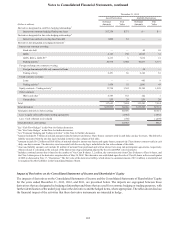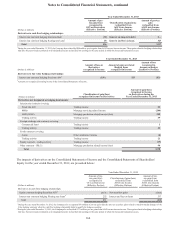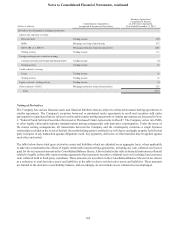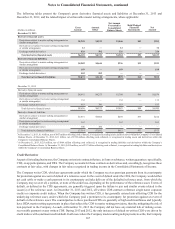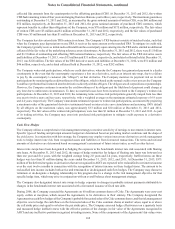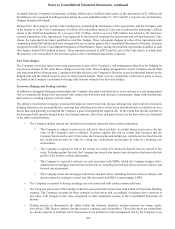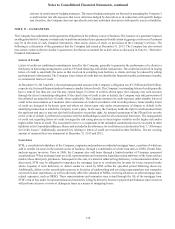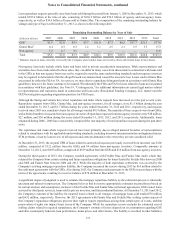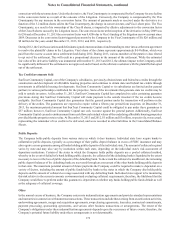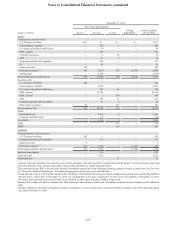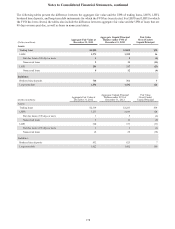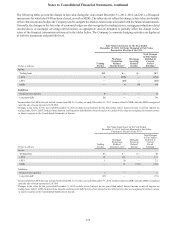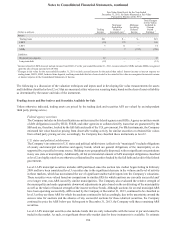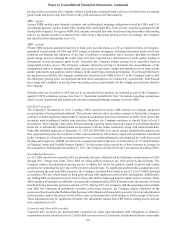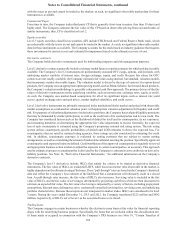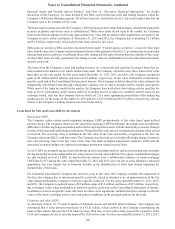SunTrust 2013 Annual Report Download - page 189
Download and view the complete annual report
Please find page 189 of the 2013 SunTrust annual report below. You can navigate through the pages in the report by either clicking on the pages listed below, or by using the keyword search tool below to find specific information within the annual report.Notes to Consolidated Financial Statements, continued
173
connection with these transactions. Under the derivative, the Visa Counterparty is compensated by the Company for any decline
in the conversion factor as a result of the outcome of the Litigation. Conversely, the Company is compensated by the Visa
Counterparty for any increase in the conversion factor. The amount of payments made or received under the derivative is a
function of the 3.2 million shares sold to the Visa Counterparty, the change in conversion rate, and Visa’s share price. The Visa
Counterparty, as a result of its ownership of the Class B shares, is impacted by dilutive adjustments to the conversion factor
of the Class B shares caused by the Litigation losses. The conversion factor at the inception of the derivative in May 2009 was
0.6296 and at December 31, 2013 the conversion factor was 0.4206 due to Visa’s funding of the litigation escrow account since
2009. Decreases in the conversion factor triggered payments by the Company to the Visa Counterparty of $0, $26 million and
$8 million for the years ended December 31, 2013, 2012, and 2011, respectively.
During 2012, the Card Associations and defendants signed a memorandum of understanding to enter into a settlement agreement
to resolve the plaintiffs' claims in the Litigation. Visa's share of the claims represents approximately $4.4 billion, which was
paid from the escrow account into a settlement fund during 2012. During 2013, various members of the putative class elected
to opt out of the settlement. This will result in a proportional decrease in the amount of the settlement. While the estimated
fair value of the derivative liability was immaterial at December 31, 2013 and 2012, the ultimate impact to the Company could
be significantly different if the settlement is not approved and/or based on the ultimate resolution with the plaintiffs that opted
out of the settlement.
Tax Credit Investments Sold
SunTrust Community Capital, one of the Company's subsidiaries, previously obtained state and federal tax credits through the
construction and development of affordable housing properties and continues to obtain state and federal tax credits through
investments in affordable housing developments. SunTrust Community Capital or its subsidiaries are limited and/or general
partners in various partnerships established for the properties. Some of the investments that generate state tax credits may be
sold to outside investors. At December 31, 2013, SunTrust Community Capital has completed six sales containing guarantee
provisions stating that SunTrust Community Capital will make payment to the outside investors if the tax credits become
ineligible. SunTrust Community Capital also guarantees that the general partner under the transaction will perform on the
delivery of the credits. The guarantees are expected to expire within a fifteen year period from inception. At December 31,
2013, the maximum potential amount that SunTrust Community Capital could be obligated to pay under these guarantees is
$37 million; however, SunTrust Community Capital can seek recourse against the general partner. Additionally, SunTrust
Community Capital can seek reimbursement from cash flow and residual values of the underlying affordable housing properties
provided that the properties retain value. At December 31, 2013 and 2012, $1 million and $3 million, respectively, was accrued,
representing the remainder of tax credits to be delivered, and were recorded in other liabilities in the Consolidated Balance
Sheets.
Public Deposits
The Company holds public deposits from various states in which it does business. Individual state laws require banks to
collateralize public deposits, typically as a percentage of their public deposit balance in excess of FDIC insurance and may
also require a cross-guarantee among all banks holding public deposits of the individual state. The amount of collateral required
varies by state and may also vary by institution within each state, depending on the individual state's risk assessment of
depository institutions. Certain of the states in which the Company holds public deposits use a pooled collateral method,
whereby in the event of default of a bank holding public deposits, the collateral of the defaulting bank is liquidated to the extent
necessary to recover the loss of public deposits of the defaulting bank. To the extent the collateral is insufficient, the remaining
public deposit balances of the defaulting bank are recovered through an assessment of the other banks holding public deposits
in that state. The maximum potential amount of future payments the Company could be required to make is dependent on a
variety of factors, including the amount of public funds held by banks in the states in which the Company also holds public
deposits and the amount of collateral coverage associated with any defaulting bank. Individual states appear to be monitoring
this risk relative to the current economic environment and evaluating collateral requirements; therefore, the likelihood that the
Company would have to perform under this guarantee is dependent on whether any banks holding public funds default as well
as the adequacy of collateral coverage.
Other
In the normal course of business, the Company enters into indemnification agreements and provides standard representations
and warranties in connection with numerous transactions. These transactions include those arising from securitization activities,
underwriting agreements, merger and acquisition agreements, swap clearing agreements, loan sales, contractual commitments,
payment processing, sponsorship agreements, and various other business transactions or arrangements. The extent of the
Company's obligations under these indemnification agreements depends upon the occurrence of future events; therefore, the
Company's potential future liability under these arrangements is not determinable.


